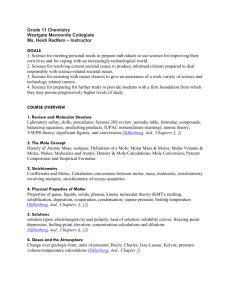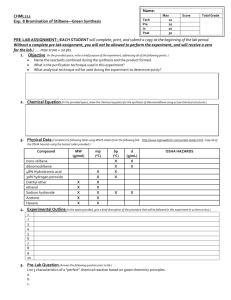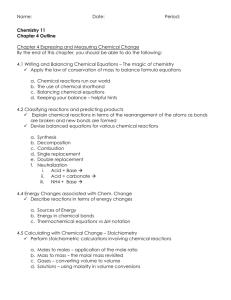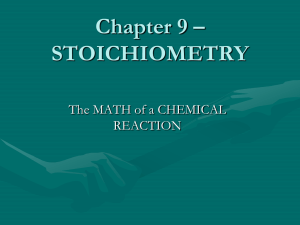Rubric for Gas Law Notebook and Theory
advertisement
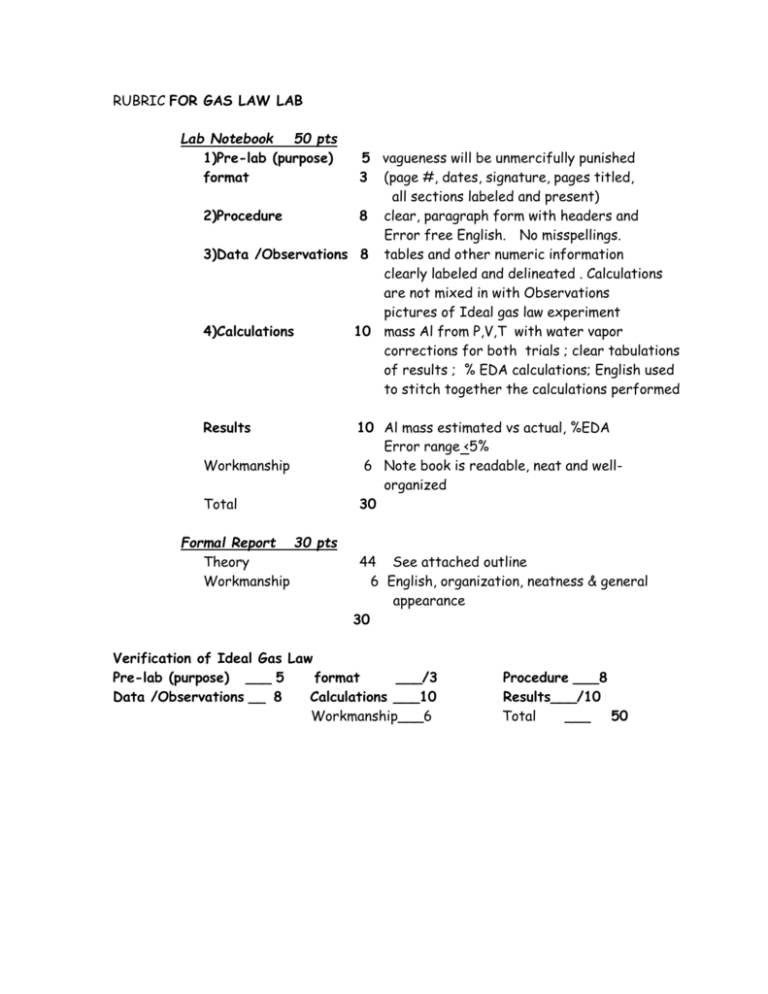
RUBRIC FOR GAS LAW LAB Lab Notebook 50 pts 1)Pre-lab (purpose) format 5 vagueness will be unmercifully punished 3 (page #, dates, signature, pages titled, all sections labeled and present) 2)Procedure 8 clear, paragraph form with headers and Error free English. No misspellings. 3)Data /Observations 8 tables and other numeric information clearly labeled and delineated . Calculations are not mixed in with Observations pictures of Ideal gas law experiment 4)Calculations 10 mass Al from P,V,T with water vapor corrections for both trials ; clear tabulations of results ; % EDA calculations; English used to stitch together the calculations performed Results Workmanship Total Formal Report 30 pts Theory Workmanship 10 Al mass estimated vs actual, %EDA Error range <5% 6 Note book is readable, neat and wellorganized 30 44 See attached outline 6 English, organization, neatness & general appearance 30 Verification of Ideal Gas Law Pre-lab (purpose) ___ 5 format ___/3 Data /Observations __ 8 Calculations ___10 Workmanship___6 Procedure ___8 Results___/10 Total ___ 50 Suggested Outline for Theory 1. The Ideal gas law Statement of law (PV=nRT); define units Microscopic assumptions (masses have no volume, elastic collisions, gas particles don’t interact)….note that R =0.08215 atm L/K mol assumes these conditions Connection of Ideal law to empiric laws (Boyle, Gay-Lussac, Avogodro, Charles) 2. Reaction Stoichiometry Statement of balanced reaction run (in molecular reaction format) Brief discussion of mole connection between Al and H2 Re-expression of mass Al to moles Al and volume H2 to moles H2 given T, Ph2 and R 3. Correction of P(obs) with H2O vapor pressure Explain how and why we correct observed barometric P=Pobs with water vapor pressure data at room temperature to extract an estimate of PH2 4. Testing the Ideal gas Law prediction Clearly express how the Ideal gas law is tested and what big assumption must be made (…that the stoichiometry and mole concepts used to compute moles are correct) Key issues How you compute Al moles from nH2 derived from Ideal gas law Rationale for why this `tests’ ideal gas law: be particularly careful to explain that if the moles of n(Al) computed from the Ideal gas law theory match that of Al derived from weight, that the theory is supported…otherwise not. Make a brief comment on how stoichiometry and mole concept form the basis of `actual’ in order to test PV-nRT validity (reflects essentially mass conservation) Briefly explain error estimation (don’t jsut parrot the equation. Explain in words what the equation below tells us.) %EDA= 100*n(Al , ideal gas prediction) - n(Al actual))/n(Al actual) 5. Expected Sources of error Discuss what you see as 3 major error sources. Note that `human error’ is not an option. Errors must be connected to perceived limitations in equipment, experiment design or assumptions . Grading Template for Theory ____/50 1. The Ideal gas law (__/5) 2. Reaction Stoichiometry (__/10) __/1 __/2 __/3 Statement of balanced reaction run (in molecular reaction format) Brief discussion of mole connection between Al and H2 Re-expression of mass Al to moles Al to moles H2 predicted by stoichiometry __/1 __/4 3. __/2 4. Statement of law (PV=nRT); define units Discuss connection of Ideal law to empiric laws (Boyle, Gay-Lussac, Avogodro, Charles) Correction of P(obs) with H2O vapor pressure (__/4) Explain how and why we correct observed barometric P=Pobs with water vapor pressure data at room temperature to extract an estimate of PH2 Testing the Ideal gas Law prediction (__/20) Clearly express how the Ideal gas law is tested and what big assumption must be made (…that the stoichiometry and mole concepts used to compute moles are correct) Key issues __/4 __/5 __/5 __/2 How you compute n(H2) moles from Ideal gas law Rationale for why this `tests’ ideal gas law: be particularly careful to explain that if the moles of n(H2) computed from the Ideal gas law theory match that of n(H2) derived from weight of Al, that the theory is supported…otherwise not. Make a brief comment on how stoichiometry and mole concept form the basis of `actual’ in order to test PVnRT validity (reflects essentially mass conservation) Briefly explain error estimation (don’t just parrot the equation. Explain in words what the equation below tells us.) %EDA= 100*n(H2 , ideal gas prediction) - n(H2 actual))/n(AH2actual) __/5 Expected Sources of error Indicate at least 3 different sources of error. FYI …”human error” and “accuracy” are not one of them. __/6 workmanship Neatness evidence of good effort clarity; English usage Verification of Ideal Gas Law Pre-lab (purpose) ___ 5 format ___/3 Data /Observations __ 8 Calculations ___10 Workmanship___6 Procedure ___8 Results___/10 Total ___ 50 Verification of Ideal Gas Law Pre-lab (purpose) ___ 5 format ___/3 Data /Observations __ 8 Calculations ___10 Workmanship___6 Procedure ___8 Results___/10 Total ___ 50 Verification of Ideal Gas Law Pre-lab (purpose) ___ 5 format ___/3 Data /Observations __ 8 Calculations ___10 Workmanship___6 Procedure ___8 Results___/10 Total ___ 50 Verification of Ideal Gas Law Pre-lab (purpose) ___ 5 format ___/3 Data /Observations __ 8 Calculations ___10 Workmanship___6 Procedure ___8 Results___/10 Total ___ 50 Verification of Ideal Gas Law Pre-lab (purpose) ___ 5 format ___/3 Data /Observations __ 8 Calculations ___10 Workmanship___6 Procedure ___8 Results___/10 Total ___ 50 Verification of Ideal Gas Law Pre-lab (purpose) ___ 5 format ___/3 Data /Observations __ 8 Calculations ___10 Workmanship___6 Procedure ___8 Results___/10 Total ___ 50 Verification of Ideal Gas Law Pre-lab (purpose) ___ 5 format ___/3 Data /Observations __ 8 Calculations ___10 Workmanship___6 Verification of Ideal Gas Law Pre-lab (purpose) ___ 5 format ___/3 Data /Observations __ 8 Calculations ___10 Workmanship___6 Procedure ___8 Results___/10 Total ___ 50 Procedure ___8 Results___/10 Total ___ 50

